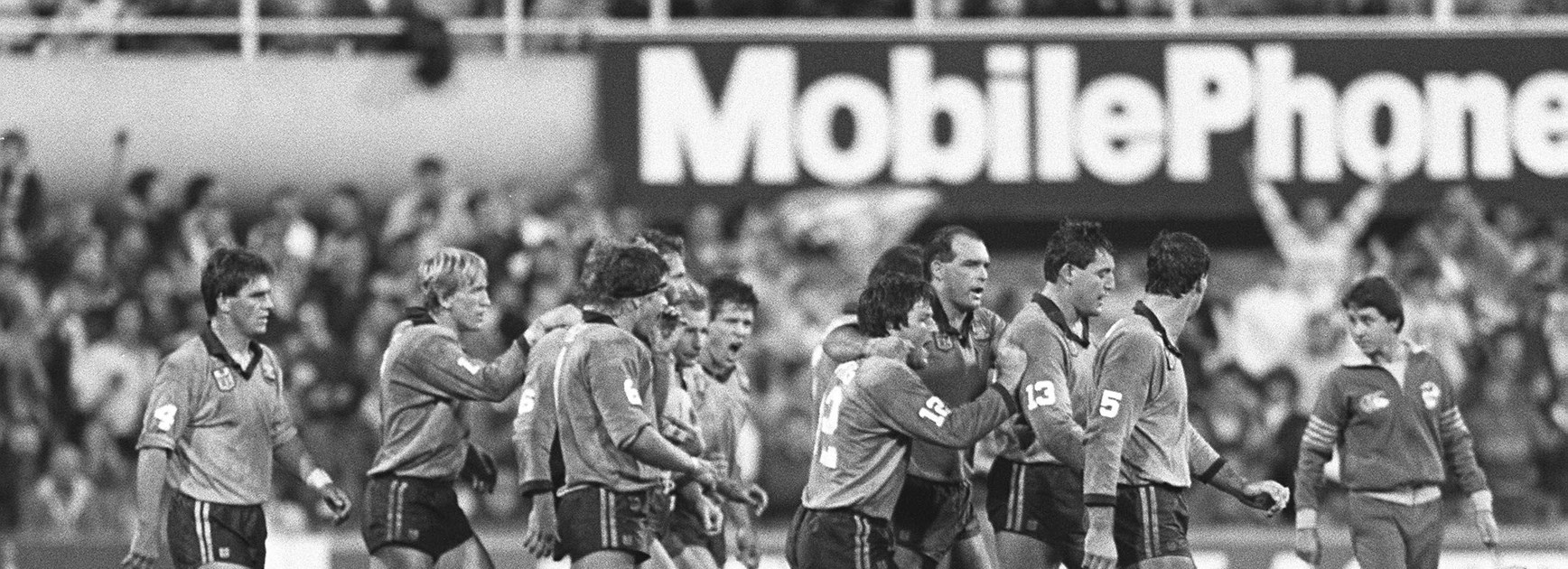By Roy Masters
Australia is the only country in the world with four codes of football, with their peak bodies being the NRL, AFL, Rugby Australia and Football Australia. Now there are five codes: State of Origin.
This annual three-game series between NSW and Queensland has become so big in terms of TV ratings, crowds, media coverage and sponsorship, it is a separate game all of its own. Even the AFL, which describes itself as the biggest sporting code in the nation, admitted following the 90,000 crowd which watched the second game at the MCG on 26 June 2024, that it is reconsidering a series involving its dominant states.
Rugby league’s State of Origin, certainly for the Blues, is lightyears ahead of where it was for the inaugural match of 1980. It’s equivalent to the difference between an end-of-season trip rugby league game in the bush in the 1970s, and north of England rival soccer clubs Liverpool and Everton fighting it out in a FA Cup final today.
Prop forward Craig Young played in the 1980 Lang Park match and later became a NSW team manager and is therefore a first rate authority on the progress made over 45 years. “Albert”, as he is nicknamed, was captain of the Dragons in 1980 and his club teammate, Rockhampton born Rod “Rocket” Reddy, had already left for Brisbane to join seven other Sydney-based players in the Queensland team.
It was an ambush the Queenslanders had been preparing for months and one they will seek to replicate on 17 July when the 2024 decider is played.
“The QRL stood Rocket down from playing in our club match, while the NSW players weren’t told of our selection until the Sunday night following the weekend game,” Albert recalls of the Blues’ two-day preparation.
“I didn’t think too much of it. I just thought it was Queensland doing what they do. Even when the Queensland fans threw full stubbies at our bus outside the ground, I didn’t take too much notice.
“But when we got into Lang Park, our dressing room door was locked. We then had to walk through the bar and the drinkers gave it to us even more. Tommy Raudonikis, our captain, wanted to fight them all. We had to restrain him.”
The team travelled to Brisbane the day before the match and Raudonikis had been for an early morning walk around the Brisbane city streets. He was widely booed and returned to the hotel and warned some of his teammates, saying, “There’s something going on here. They are up for this game.”
However, Albert, a regular test prop and a 1978 Kangaroo, didn’t realise the enormity of the task ahead until he reached Lang Park. “It wasn’t until we had to pull Tommy away from the mob in the bar that I realised there was something different going on,” he said.
“Plus the game was refereed by a Pommy (Billy Thompson who died in 2021). We got information he was having a week’s holiday at Hamilton Island after the match.”
Albert, then a serving detective in the NSW Police force, later made some enquiries.
“Sure enough, his name was on the airline passenger list.”
Another of the inaugural Blues, Jim Leis, had enjoyed a meteoric rise from playing in Tamworth in 1979, cementing a position in first grade in 1980 with the Magpies team in Sydney I coached, and then selected in the Australian team for a mid-year tour of New Zealand. He was chosen as lock for NSW following the withdrawal of Ray Price. Despite his rapid Rugby League education, it was still a shock for Jim.
“We got picked up from our hotel in a bus that looked like the oldest one in Queensland,” he said.
“Even Western Suburbs, the fibro club, had better busses than it. I got spat on walking through the gate. That was my welcome to Queensland.”
He admits he still hadn’t realised the enormity of what lay ahead until the Maroons, led by a 35-year-old Arthur Beetson, ran onto the field. “The crowd (33,000) went ballistic,” Jim recalls.
“Big Artie’s eyes were rolling. Whatever salt tablets he was on, they were better than the ones you gave us at Western Suburbs.”
Jim says of the roar which greeted the Queensland team as the moment, “that it really stuck with me what Origin meant.
“It was the start of something. I can’t believe how much it has grown to now.”
Leis was paid 200 dollars and given a tracksuit. “The winning team, Queensland, got 1000 dollars a man,” he recalls.
Compare that to today’s payment of $30,000 a match, which is probably double what Leis and his Western Suburbs teammate and Blues second-rower, the late Bob Cooper, were paid for a full club season.
Leis recalls the non-playing NSW staff consisted of a coach, a doctor, a trainer and two managers. The managers, usually Sydney club secretaries, treated the travel to Brisbane as a trip away. An all expenses paid seafood lunch as Gambaros (now owned by the ARLC) wasn’t a good example for the players.
Ted Glossop, the Canterbury coach, doubled as boss of the Blues. Today, NSW coach Michael “Madge” Maguire has already devoted almost a year to the Blues preparation and has four assistant coaches, an analyst with access to the latest computer technology and GPS data, two doctors, two physiotherapists and two strength and conditioning coaches plus media professionals. The team set up camp for 10 days before matches and was based at a Blue Mountains resort.
Greg Brentnall, chosen as a winger for that first Origin match, admits he was not prepared for the 1980 ambush. “I never bought into Origin,” he concedes.
“I viewed it as a selection trial for the Australian team. Most of us approached it the same way. It was not a major event in our careers. My heroes were all Australian players. It wasn’t until I saw what Steve Mortimer, my teammate at Canterbury and NSW captain in 1984-85, was experiencing with his brother Chris that I realised the importance of Origin.”
Brentnall is impressed with Madge’s preparation to date and his integration of former NSW players in the planning and motivation. The approach is also far more family integrated, with the players’ wives and children involved. Family members presented rookie Origin players with their jumpers before the first two games. Current team manager Frank Ponissi, an integral part of the Storm’s success these past two decades, says, “All the players selected come from NRL clubs with highly professional staff. The players expect a high level of care and it is our duty to provide it. Furthermore, because those clubs pay the players’ salaries, we have a duty of care to the clubs.”
The selected players, in turn, have a duty to reciprocate that high level of care by playing the best game they possibly can. NSW players 40 years ago may have been justified in believing the Blues administration did not back them to the extent that the Queensland players had been given every support, including to their families. The same excuse carries no weight today. Maguire has invested heavily in the sanctity of the NSW jumper and his players, including those dropped after the first game, have bought into the Blues brotherhood culture.








